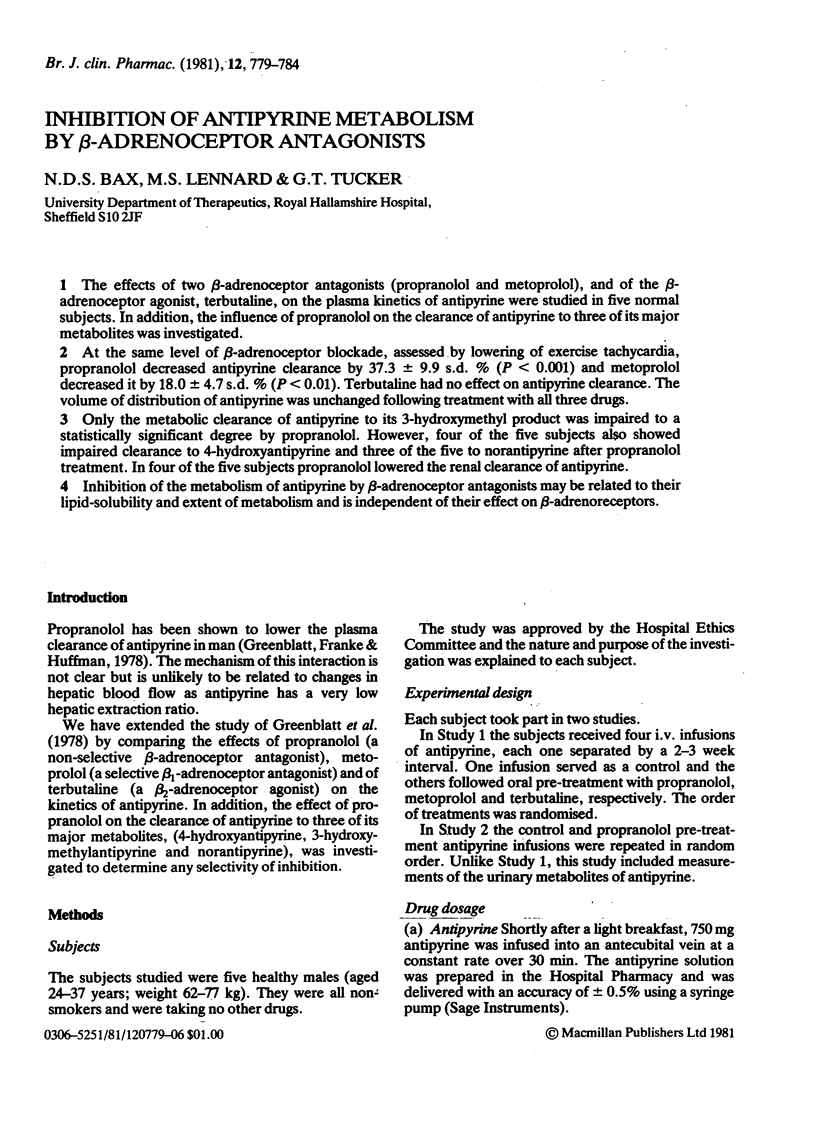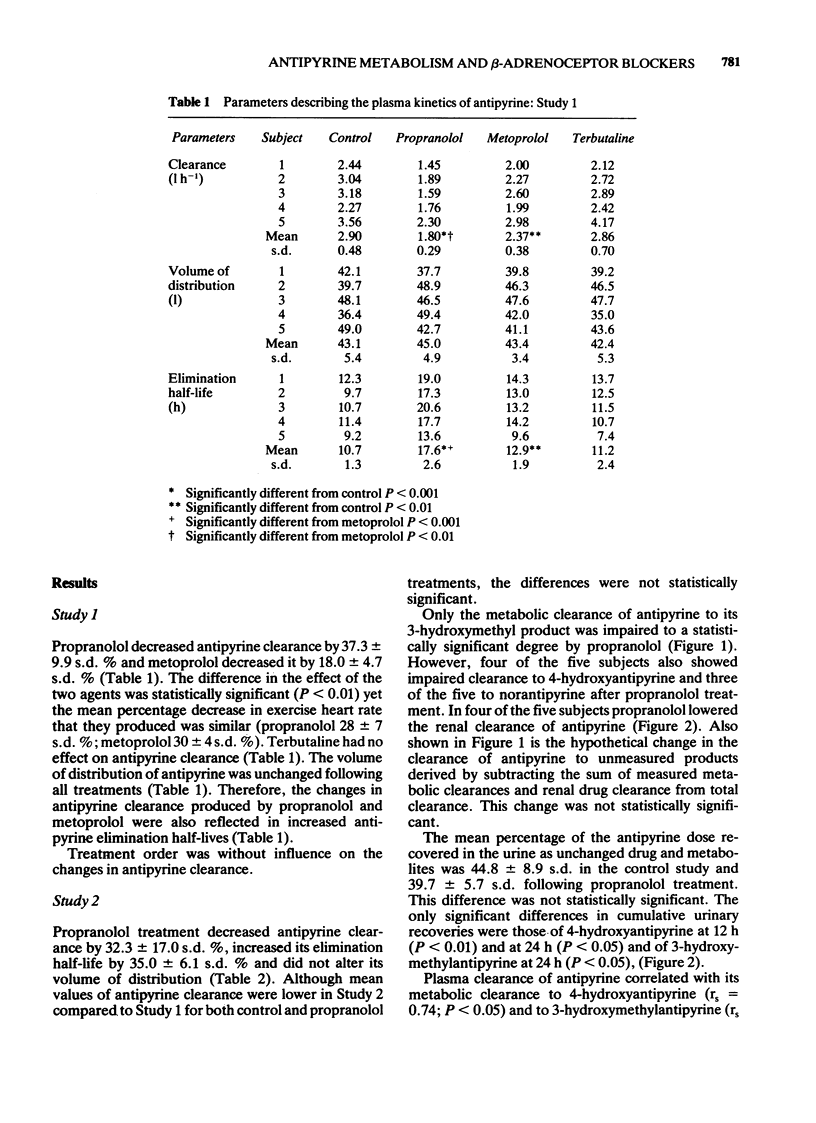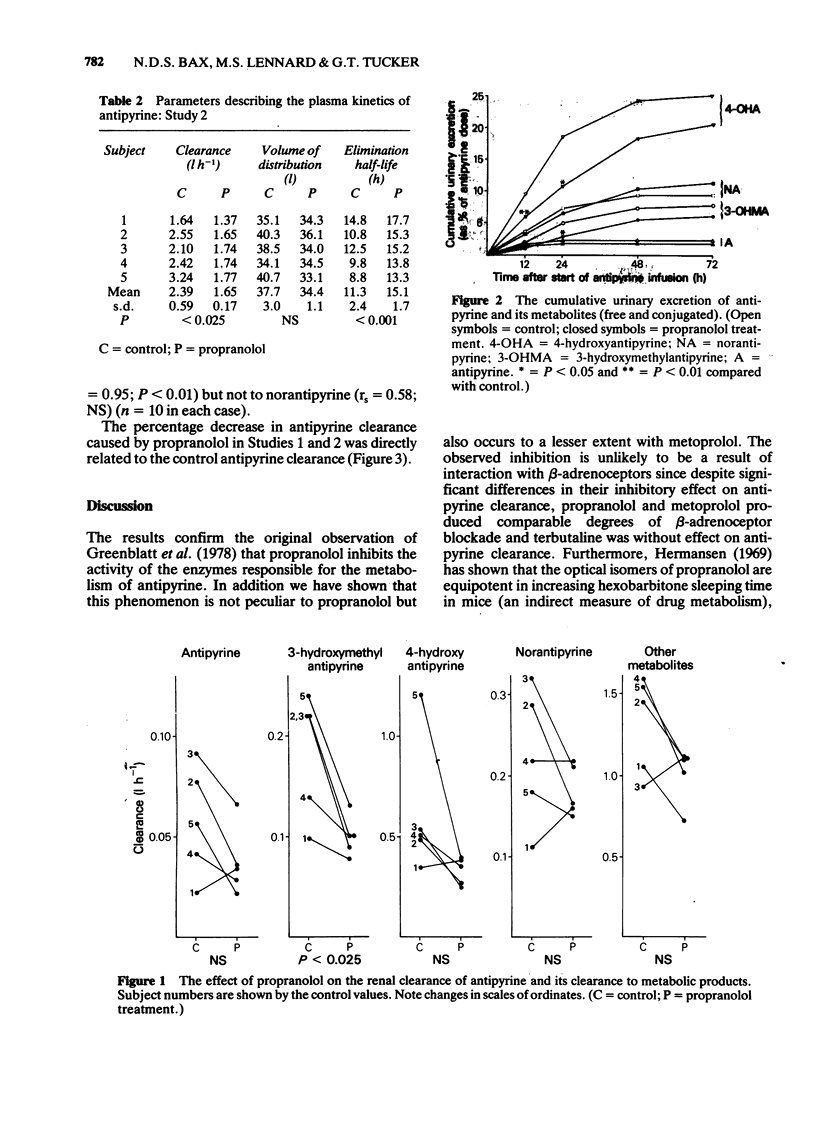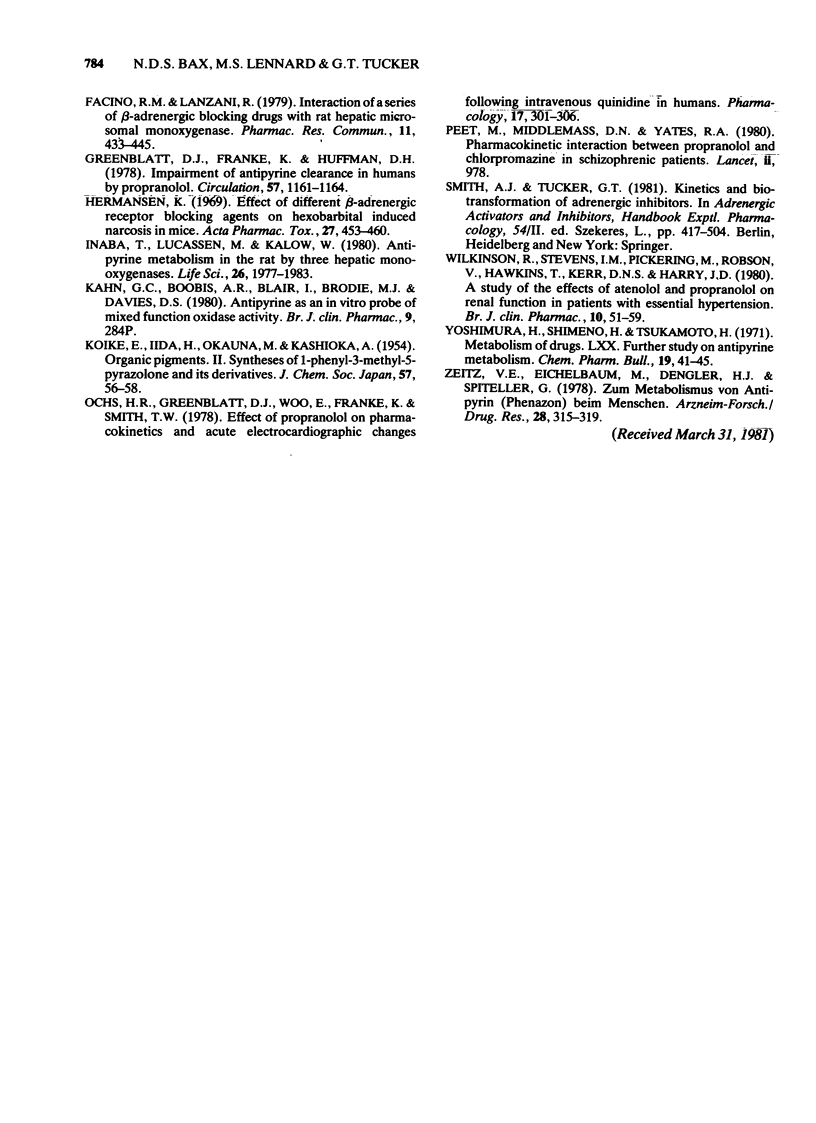Abstract
1 The effects of two beta-adrenoceptor antagonists (propranolol and metoprolol), and of the beta-adrenoceptor agonist, terbutaline, on the plasma kinetics of antipyrine were studied in five normal subjects. In addition, the influence of propranolol on the clearance of antipyrine to three of its major metabolites was investigated. 2 At the same level of beta-adrenoceptor blockade, assessed by lowering of exercise tachycardia, propranolol decreased antipyrine clearance by 37.3 +/- 9.9 s.d. % (P less than 0.001) and metoprolol decreased it by 18.0 +/- 4.7 s.d. % (P less than 0.01). Terbutaline had no effect on antipyrine clearance. The volume of distribution of antipyrine was unchanged following treatment with all three drugs. 3 Only the metabolic clearance of antipyrine to its 3-hydroxymethyl product was impaired to a statistically significant degree by propranolol. However, four of the five subjects also showed impaired clearance to 4-hydroxyantipyrine and three of the five to norantipyrine after propranolol treatment. In four of the five subjects propranolol lowered the renal clearance of antipyrine. 4 Inhibition of the metabolism of antipyrine by beta-adrenoceptor antagonists may be related to their lipid-solubility and extent of metabolism and is independent of their effect on beta-adrenoreceptors.
Full text
PDF





Selected References
These references are in PubMed. This may not be the complete list of references from this article.
- Brunk S. F., Delle M., Wilson W. R. Effect of propranolol on morphine metabolism. Clin Pharmacol Ther. 1974 Dec;16(6):1039–1044. doi: 10.1002/cpt19741661039. [DOI] [PubMed] [Google Scholar]
- Conrad K. A., Nyman D. W. Effects of metoprolol and propranolol on theophylline elimination. Clin Pharmacol Ther. 1980 Oct;28(4):463–467. doi: 10.1038/clpt.1980.189. [DOI] [PubMed] [Google Scholar]
- Danhof M., Breimer D. D. Studies on the different metabolic pathways of antipyrine in man. I. Oral administration of 250, 500 and 1000 mg to healthy volunteers. Br J Clin Pharmacol. 1979 Dec;8(6):529–537. doi: 10.1111/j.1365-2125.1979.tb01040.x. [DOI] [PMC free article] [PubMed] [Google Scholar]
- Danhof M., Groot-van der Vis E., Breiner D. D. Assay of antipyrine and its primary metabolites in plasma, saliva and urine by high-performance liquid chromatography and some preliminary results in man. Pharmacology. 1979;18(4):210–223. doi: 10.1159/000137254. [DOI] [PubMed] [Google Scholar]
- Danhof M., Krom D. P., Breimer D. D. Studies on the different metabolic pathways of antipyrine in rats: influence of phenobarbital and 3-methylcholanthrene treatment. Xenobiotica. 1979 Nov;9(11):695–702. doi: 10.3109/00498257909042337. [DOI] [PubMed] [Google Scholar]
- Facino R. M., Lanzani R. Interaction of a series of beta-adrenergic blocking drugs with rat hepatic microsomal monooxygenase. Pharmacol Res Commun. 1979 May;11(5):433–445. doi: 10.1016/s0031-6989(79)80007-7. [DOI] [PubMed] [Google Scholar]
- Greenblatt D. J., Franke K., Huffman D. H. Impairment of antipyrine clearance in humans by propranolol. Circulation. 1978 Jun;57(6):1161–1164. doi: 10.1161/01.cir.57.6.1161. [DOI] [PubMed] [Google Scholar]
- Hermansen K. Effect of different beta-adrenergic receptor blocking agents on hexobarbital induced narcosis in mice. Acta Pharmacol Toxicol (Copenh) 1969;27(6):453–460. doi: 10.1111/j.1600-0773.1969.tb00493.x. [DOI] [PubMed] [Google Scholar]
- Inaba T., Lucassen M., Kalow W. Antipyrine metabolism in the rat by three hepatic monooxygenases. Life Sci. 1980 Jun 9;26(23):1977–1983. doi: 10.1016/0024-3205(80)90629-3. [DOI] [PubMed] [Google Scholar]
- Kahn G. C., Boobis A. R., Blair I., Brodie M. J., Davies D. S. Antipyrine as an in vitro probe of mixed function oxidase activity [proceeding]. Br J Clin Pharmacol. 1980 Mar;9(3):284P–284P. doi: 10.1111/j.1365-2125.1980.tb04844.x. [DOI] [PubMed] [Google Scholar]
- Ochs H. R., Greenblatt D. J., Woo E., Franke K., Smith T. W. Effect of propranolol on pharmacokinetics and acute electrocardiographic changes following intravenous quinidine in humans. Pharmacology. 1978;17(6):301–306. doi: 10.1159/000136870. [DOI] [PubMed] [Google Scholar]
- Peet M., Middlemiss D. N., Yates R. A. Pharmacokinetic interaction between propranolol and chlorpromazine in schizophrenic patients. Lancet. 1980 Nov 1;2(8201):978–978. doi: 10.1016/s0140-6736(80)92135-2. [DOI] [PubMed] [Google Scholar]
- Wilkinson R., Stevens I. M., Pickering M., Robson V., Hawkins T., Kerr D. N., Harry J. D. A study of the effects of atenolol and propranolol on renal function in patients with essential hypertension. Br J Clin Pharmacol. 1980 Jul;10(1):51–59. doi: 10.1111/j.1365-2125.1980.tb00501.x. [DOI] [PMC free article] [PubMed] [Google Scholar]
- Yoshimura H., Shimeno H., Tsukamoto H. Metabolism of drugs. LXX. Further study on antipyrine metabolism. Chem Pharm Bull (Tokyo) 1971 Jan;19(1):41–45. doi: 10.1248/cpb.19.41. [DOI] [PubMed] [Google Scholar]
- Zietz E., Eichelbaum M., Dengler H. J., Spiteller G. Zum Metabolismus von Antipyrin (Phenazon) beim Menschen. Arzneimittelforschung. 1978;28(2):315–319. [PubMed] [Google Scholar]


